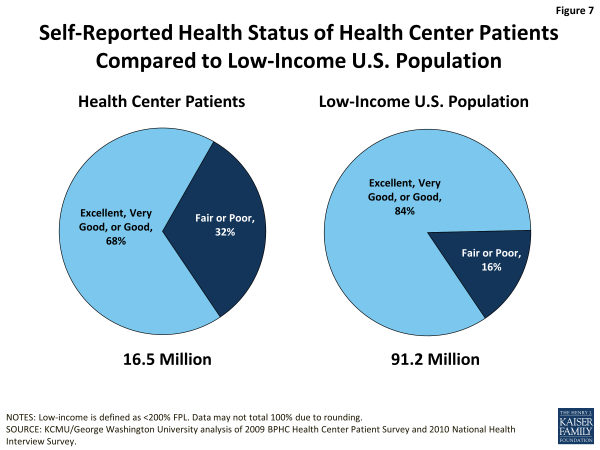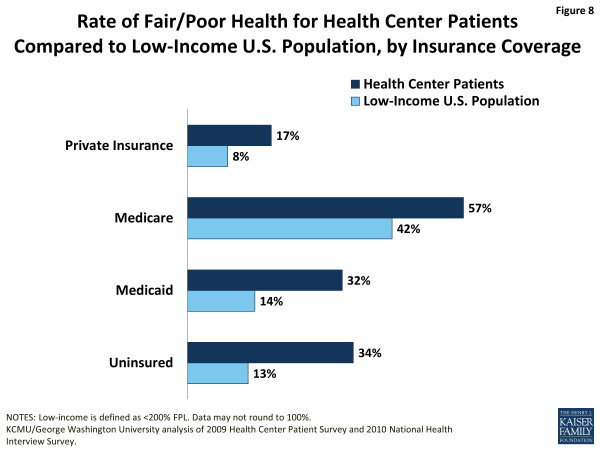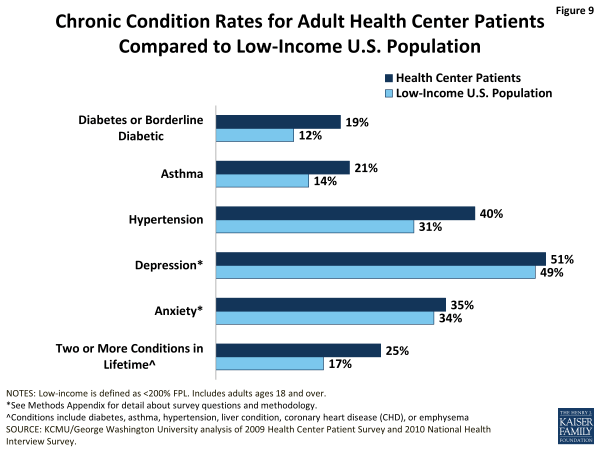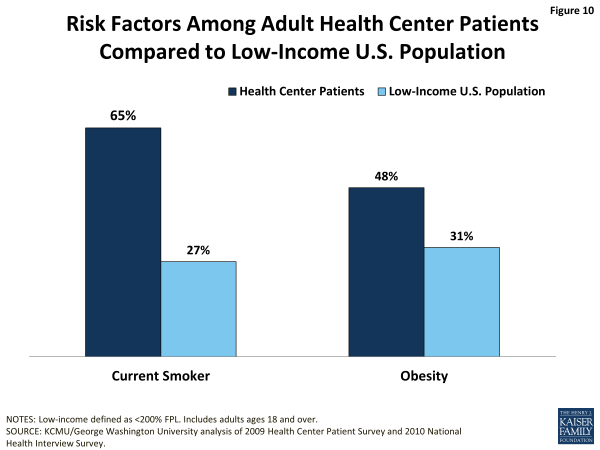A Profile of Community Health Center Patients: Implications for Policy
Health Status
Health center patients are in poorer health than the low-income population overall. They report poorer health status, more chronic health conditions, and higher rates of smoking and obesity. These patterns reflect underlying differences in health status between health center patients and the general low-income population, but also the fact that people who seek health care — here, health center users — are, by definition, likely to need services, whereas the overall low-income population includes both health care users and non-users, whose health care needs presumably are more limited. The data show that health center patients are a population with substantial needs for health care.
Self-reported health status. Health center patients are twice as likely as low-income people overall to report being in fair or poor health, as opposed to excellent, very good, or good health (32% vs. 16%) (Figure 7). It is important to note again that, because all individuals participating in the Health Center Patient Survey are seeking care, they might be more likely to be in fair or poor health than the broader low-income population captured in the NHIS, a household survey that includes both users and non-users.
Self-reported health status, by insurance coverage. Health center patients are more likely to report being in fair or poor health than the general low-income population, not only in the aggregate but also within different health insurance categories. Among the privately insured, the share reporting fair/poor health is twice as high for health center patients as for low-income people overall (17% vs. 8%) (Figure 8). Within the Medicare, Medicaid, and uninsured populations, which have much higher rates of fair/poor health than the privately insured, the rates for health center patients far exceed those for low-income people overall in the same coverage group. Among Medicaid beneficiaries, 42% of all low-income people but 57% of health center patients report fair/poor health. Among both Medicaid beneficiaries and the uninsured, 1 in 3 health center patients reports being in fair/poor health, compared to about 1 in 7 low-income individuals generally. These findings point to health centers as a locus of care for a subgroup of the low-income population that has substantial health burdens.
Chronic conditions. Adult health center patients are more likely than low-income adults overall to report that they have had one or more of a number of major chronic conditions during their lifetime. In particular, adult health center patients report rates of diabetes and asthma 50% higher than in the total low-income adult population (Figure 9). They also report higher rates of hypertension. In addition, a quarter of all adult health center patients report having had two or more chronic conditions, compared to 17% of all low-income adults. Half of both adult health center patients and low-income adults overall report depression, and about a third of both populations report anxiety. These high rates of mental health conditions may in part stem from the way the survey questions related to these conditions were framed. The Health Center Patient Survey asked patients to self-report whether they had ever had depression or anxiety in their lifetime. The NHIS asked only a subsample of adults who reported symptoms of anxiety/depression whether they had been told by a medical professional that they had either of these conditions.
The high rates of chronic illness among adult health center patients may be one reason these individuals presented for care. The high rates also reveal that care of people with chronic diseases and conditions is central to the work of health centers.
Health risk factors. Smoking and obesity rates are not only high among adult health center patients, but also much higher than for the low-income population overall. Nearly two-thirds (65%) of health center patients are current smokers, compared to about a quarter (27%) of all low-income adults (Figure 10). Almost half are obese, compared to 31% of low-income adults overall. Smoking and obesity are closely linked with serious health problems such as cardiovascular disease and diabetes. The very high prevalence of these risk factors in the health center population may help to explain the patterns in chronic disease prevalence discussed above.




